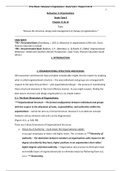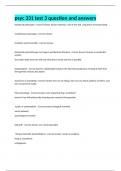© Du Plessis - Behaviour in Organizations – Study Task 6 – Chapter 15 & 16
1
Behaviour in Organizations
Study Task 6
Chapter 15 & 16
Topic:
“Discuss the structure, design and management of change of organisations.”
___________________________________________________________________________
TAKE NOTE:
*PB = Prescribed Book (Greenberg, J. (2011). Behaviour in organizations (10th ed.). Essex:
Pearson Education Limited)
*RB = Recommended Book (Robbins, S.P., Odendaal, A., & Roodt, G. (2004). Organisational
Behaviour: Global and Southern African Perspectives. Cape Town, Pearson Education South
Africa.)
1. INTRODUCTION:
2. ORGANISATIONAL STRUCTURE AND DESIGN:
OB researchers and theorists have provided considerable insight into the matter by studying
what is called organizational structure – the way individuals and groups are arranged with
respect to the tasks they perform – and organizational design – the process of coordinating
these structural elements in the most effective manner. As you might suspect, finding the
best way to structure and design organisations is no simple matter.
2.1. The Basic Dimensions of Organisations:
***Organisational Structure – The formal configuration between individuals and groups
with the respect to the allocation of tasks, responsibilities, and authorities within the
organisations – cannot be seen as a formal structure, because it is an abstract concept.
However various divisions and units can be diagrammed.
(Figure 15.1, p. 549, PB)
There are 5 Basic Dimensions of Organisational Structure:
a. Hierarchy of Authority – Up & Down the Organisational Ladder:
In you get employees at lower and higher levels. This is known as ***Hierarchy of
Authority – The distinction between members of organisations with respect to the
degree of authority they have; higher positions in an organisation chart reflect
higher degrees of formal authority. – Organisation also practice to eliminate lower
and middle layers of organisational jobs to eliminate waste by flattening them out,
a.k.a. ***downsizing.
, © Du Plessis - Behaviour in Organizations – Study Task 6 – Chapter 15 & 16
2
b. Span of Control – Breadth of Responsibility:
Over how many individuals should a manager have responsibility? This is known as
the ***Span of Control – The number of subordinates in an organisation who are
supervised by managers. – You get a narrow span and a wide span of control. A Flat
Hierarchy is where a manager’s span is very wide. When it is a Tall Organisation the
manager’s span of control is narrow. An organisational chart doesn’t necessarily
show a managers span of control. It is also depended on the organisations size and
form on how many individuals should be in the control of one manager.
(Figure 15.3, p. 551, PB)
c. Division of Labour – Carving Up the Work to Be Done:
***Division of Labour – The process of dividing the many tasks performed within
the organisation into particular jobs. – The more that tasks are divided into
separate jobs, the more those jobs are specialized and the narrower the range of
activities that job incumbents are required to perform. In theory the fewer tasks one
performs the better he/she is expected to execute them, freeing others to do the
tasks at which they excel.
d. Line Versus Staff Positions – Decision Makers Versus Advisers:
(Figure 15.4, p. 553, PB)
People occupying line positions have decision making power. Staff positions is
occupied by human resource managers providing specialized services regarding
testing and interviewing procedures as well as information about the latest laws on
personnel discrimination. However ultimately decisions on personnel selection in key
positions, are likely to be made by senior managers in specialized areas.
e. Decentralization – Delegating Power Downward:
***Decentralisation – The extent to which authority and decision making are
spread throughout all levels of an organisation rather than being reserved for top
management.
***Centralisation – The tendency for just a few powerful individuals or groups to
hold most of the decision-making power.
(Table 15.2, p. 554, PB)
, © Du Plessis - Behaviour in Organizations – Study Task 6 – Chapter 15 & 16
3
2.2. Departmentalization – Ways of Structuring Organisations:
***Departmentalization – The process of breaking up organisations into coherent units.
a. Functional Organisations – Departmentalization by Task:
Because it is the form organisations usually take when they first created, and
because it is how we usually think of business, the ***functional organisation can
be considered the most basic approach to departmentalization. Naturally, as
organisations grow and become more complex, additional departments are added or
deleted as the need arises.
(Figure 15.5, p. 555, PB)
b. Product Organisations – Departmentalization by Type of Output:
Organisations do not stand still; they change constantly in size and scope. As they
develop new products and seek new customers, they might find that a functional
structure doesn’t work as well as it once did. ***Product Organisation – The type of
departmentalisation based on the products (or product lines) produced. – When
organisations are departmentalized by products, separate divisions are established,
each of which is devoted to certain product or group of products.
(Figure 15.6, p. 566, PB)
c. Matrix Organisations – Departmentalization by Both Function and Product:
***Matrix Organisations – The type of organisation in which a product or project
form is superimposed on a functional form. – The type of organisation in which n
employee is required to report to both a functional (or division) manager and the
manager of a specific project (or product). This is also known as dual authority.
(Figure 15.7, p. 557, PB)
i. Degree of Performance:
Not all organisations using the matrix structure do so on a permanent basis.
Several partial, or temporary, types of matrix design have been identified,
temporary overlay. Opposite of this is permanent overlay, teams that keep
going till the job is done. Mature matrix organisations, those in which both
the functional lines and product lines are permanent and equally string
within the organisation.






